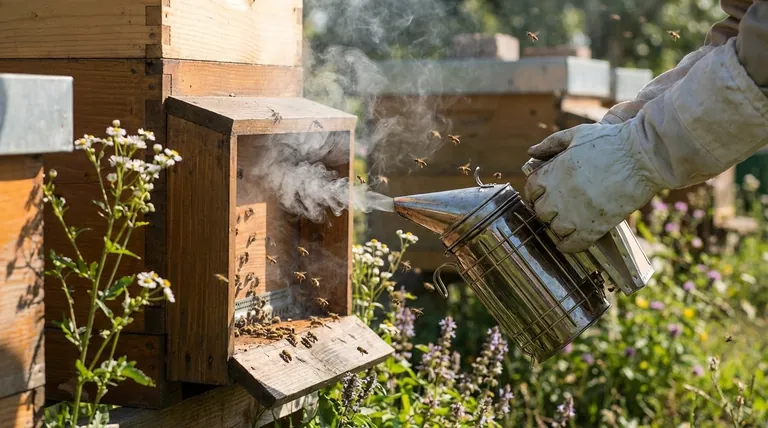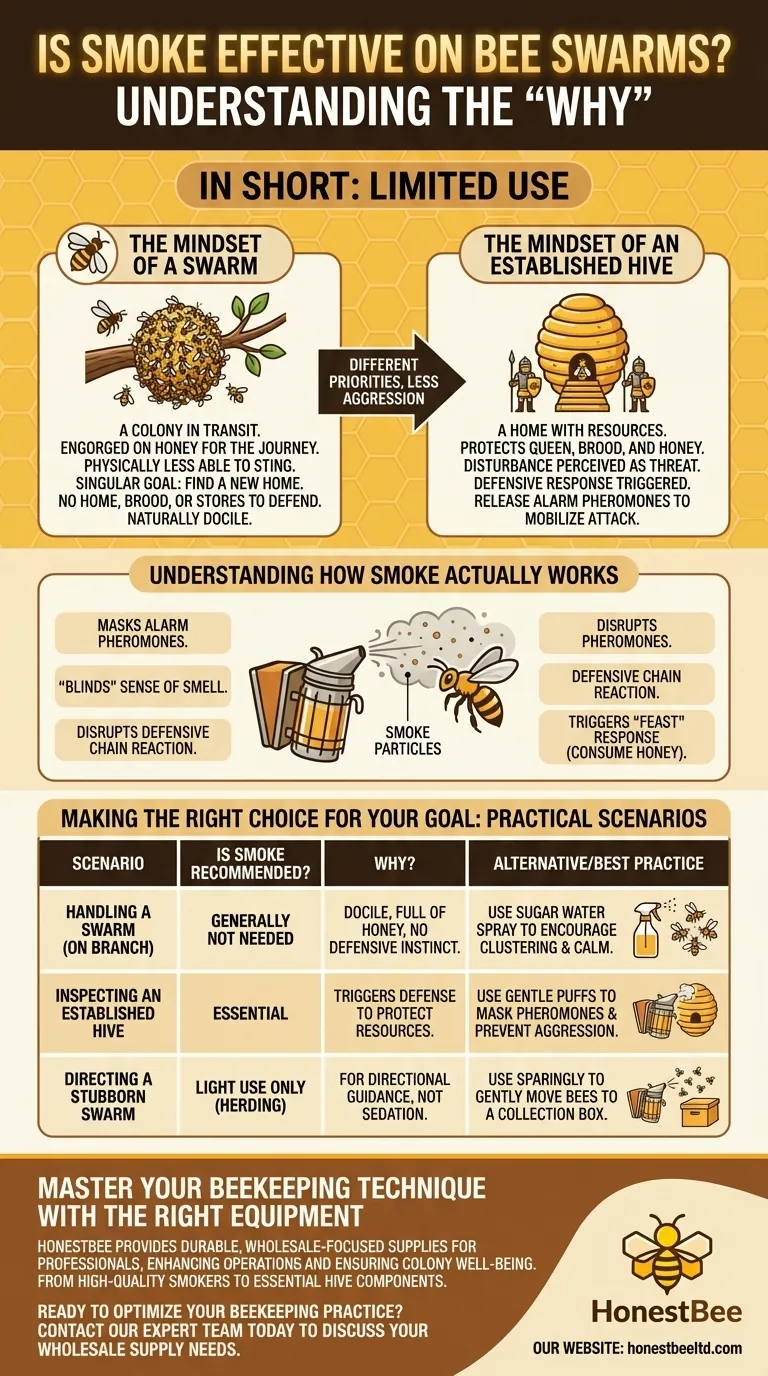In short, smoke is of limited use on a bee swarm. The primary reason is that swarming bees have a different set of priorities than bees in an established hive. A fresh swarm has already filled up on honey from its old home and has no new territory, brood, or food stores to defend, making the bees naturally docile and less prone to aggression.
The effectiveness of smoke is directly tied to a colony's defensive instinct. Since a swarm lacks a home to protect, it isn't in a defensive state, rendering the calming effect of smoke largely unnecessary.

Why Swarms and Hives Behave Differently
To understand the role of smoke, you must first understand the "mindset" of the bees in their current situation. The behavior of a swarm is fundamentally different from that of a colony in a hive.
The Mindset of a Swarm
A swarm is a colony in transit. Its collective goal is singular: find and move into a new permanent home.
The bees prepare for this journey by engorging themselves on honey. This serves as their fuel for the trip and the energy needed to begin building wax comb in their new location. A bee with a full abdomen is physically less able to curl its body to sting and is generally more focused on survival than defense.
The Mindset of an Established Hive
An established hive is a home. It contains the colony's most precious resources: the queen, brood (developing bees), and stored honey and pollen.
Any disturbance to the hive is perceived as a direct threat to the colony's future. This triggers a powerful defensive response, where guard bees release alarm pheromones to mobilize the colony to attack the intruder.
Understanding How Smoke Actually Works
Smoke is not a magical calming agent; it's a tool that exploits the bees' natural instincts and communication methods.
Disrupting the Alarm System
When a bee feels threatened or stings, it releases alarm pheromones. This chemical signal acts as a beacon, alerting other bees to the location of the threat and inciting them to attack the same spot.
The Masking Effect of Smoke
Smoke works primarily by masking these pheromones. The fine particles in the smoke overwhelm the sensory receptors on the bees' antennae, effectively "blinding" their sense of smell.
This disruption prevents the alarm signal from spreading throughout the colony, stopping a defensive chain reaction before it can begin. It allows a beekeeper to open and inspect a hive without causing mass panic and aggression.
Triggering a "Feast" Response
A secondary effect of smoke is that it can trigger an instinctual response related to fire. The bees may perceive the smoke as a nearby forest fire, causing them to consume honey in preparation to potentially abandon the hive. As noted before, a bee full of honey is a calmer bee.
Understanding the Practical Scenarios
The context of the bee encounter dictates whether smoke is a useful tool.
When Handling a Swarm
For a typical swarm clustered on a tree branch, smoke is generally not needed. They are already in their calmest, most docile state.
A light spray of sugar water (1:1 sugar to water) is often a more effective tool. It gives the bees a food source, encourages them to cluster more tightly, and makes them slightly heavier, discouraging flight during collection.
When Inspecting an Established Hive
This is the primary and correct use for a smoker. Gentle puffs of smoke at the entrance and under the lid before opening the hive are essential for a calm inspection.
During the inspection, small puffs can be used to move bees away from a specific area or to quell any rising agitation.
The Exception: Directing a Stubborn Swarm
In rare cases, a very light puff of smoke can be used to gently "herd" a swarm. For example, if a swarm is in a difficult-to-reach spot, a little smoke from one side can encourage them to move toward an open collection box on the other. Here, smoke is used for direction, not sedation.
Making the Right Choice for Your Goal
Your approach should always be guided by the bees' behavior and situation.
- If your primary focus is capturing a swarm on a branch: Assume they are docile. Use a gentle spray of sugar water instead of smoke to encourage clustering and make collection easier.
- If your primary focus is inspecting an established hive: Use smoke methodically and calmly to mask alarm pheromones and prevent a defensive response from the colony.
- If your primary focus is bees in a wall or structure: Do not treat them like a temporary swarm. This is an established colony that will be highly defensive; contact a professional beekeeper or removal expert for assistance.
Understanding the "why" behind bee behavior is the key to working with them safely and effectively.
Summary Table:
| Scenario | Is Smoke Recommended? | Why? | Alternative/Best Practice |
|---|---|---|---|
| Handling a Swarm | Generally not needed | Swarming bees are docile, have no home to defend, and are full of honey. | Use a light spray of sugar water to encourage clustering. |
| Inspecting an Established Hive | Essential | Triggers defensive instincts to protect brood and honey stores. | Use gentle puffs to mask alarm pheromones and calm the colony. |
| Directing a Stubborn Swarm | Light use only | Not for sedation, but to gently "herd" bees from one spot to another. | Use sparingly for directional guidance. |
Master Your Beekeeping Technique with the Right Equipment
Understanding bee behavior is the first step; having the right tools is the next. Whether you're a commercial apiary managing hundreds of hives or a distributor supplying the beekeeping community, HONESTBEE provides the durable, wholesale-focused supplies you need to work safely and effectively.
We equip professionals with everything from high-quality smokers and protective gear to essential hive components. Let us help you enhance your operations and ensure the well-being of your colonies.
Ready to optimize your beekeeping practice? Contact our expert team today to discuss your wholesale supply needs.
Visual Guide

Related Products
- European Stainless Steel Bee Smoker for Honey Bee Hive
- Stainless Steel Honey Bee Smoker Hive and Honeycomb Smoker for Beekeeping
- Economy Galvanized Beekeeping Honey Bee Smoker for Wholesale
- Premium Traditional Copper Bee Smoker with Bellows
- Electric Bee Smoker European Style Bee Hive Smoker for Beekeeping
People Also Ask
- What are the advantages of a high-quality bee smoker? Achieve Calm, Confident Hive Management
- What are the key benefits of using a bee smoker? Master Hive Inspections Safely and Efficiently
- What are the benefits of smoking bees? Achieve Safer, Calmer Hive Inspections
- What are the benefits of cleaning a bee smoker? Ensure Hive Safety and Bee Health
- What are the differences between stainless steel and galvanized steel bee smokers? Choose the Right Smoker for Your Apiary



















